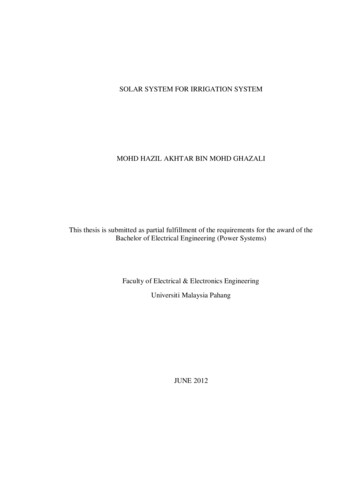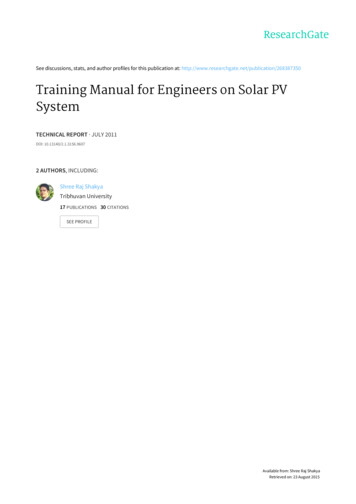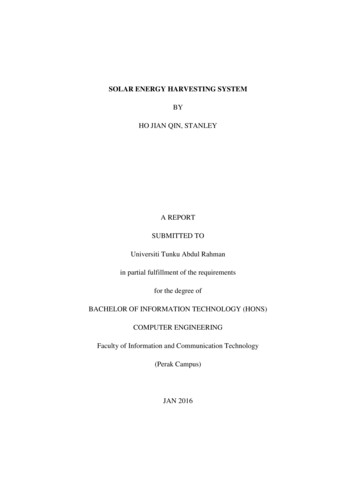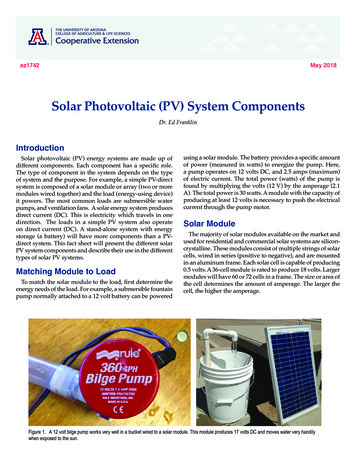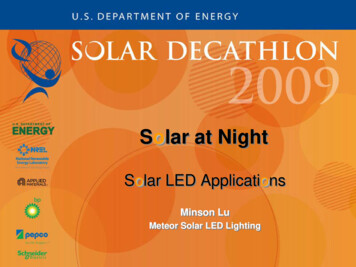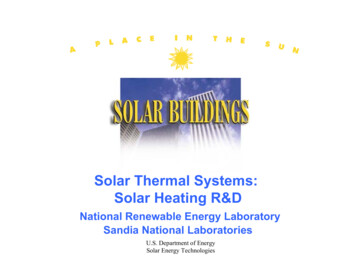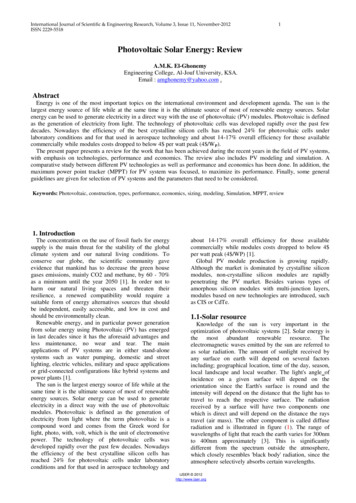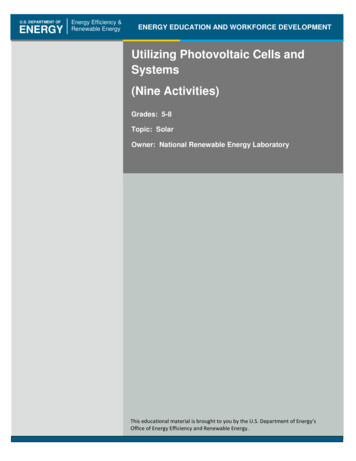
Transcription
U.S. DEPARTMENT OFENERGYEnergy Efficiency &Renewable EnergyENERGY EDUCATION AND WORKFORCE DEVELOPMENTUtilizing Photovoltaic Cells andSystems(Nine Activities)Grades: 5-8Topic: SolarOwner: National Renewable Energy LaboratoryThis educational material is brought to you by the U.S. Department of Energy’sOffice of Energy Efficiency and Renewable Energy.
This lesson plan may contain links to other resources,including suggestions as to where to purchase materials.These links, product descriptions, and prices may change over time.Utillizing Photovoltataic Ceells annd SysstemssFor thhe TeachherAs teachers, we want students tolearn abbout energyy, how wee use it, anndom. It is immportant thaatwhere itt comes frostudentss becomee aware of botthrenewabble and noonrenewable forms ofenergy resources so that ass they groowinto aduults they caan be informed citizennsn make goood choicess about thheand canresourcees they use.One renewable resourcce that mannyof us use today is solar energy. Solaarenergy is used in residenntial homes,industriaal applicattions, cenntral poweerstations,, commercial buildingss, and moree.Studentss may knoow a little about solaarenergy, as some of their hommes may ussesolar panels for heating or coolinngpurposes. The foollowing prrojects alloowstudentsstoseetuptheirowwninvestigaations andd manipulaate variableessurroundding photoovoltaic ceells.Thesseprojects can be easily integrated into anormal science claassroom cuurriculum, orcan be completed by studentss individuallyfor sciennce fair projjects.All of the projects listed will fitnto classrooom lessons surroundinngeasily inscientificc inquiry and the scientifficmethod.The projects willl also helpe concepts about elecctricity, lighhtillustrateand coloor, velocity and gravitty, chemistrryd could evven lead toand polarity, andtor soocial action projects.social studiesAt NREL scieentists are researchinggways to make solarr energy eaasier anduthors ofless expensive to use. The authis secttion are studying differenttransparrent conduccting oxidess (the73semicconductors on the surfface ofphotoovoltaic cellls) to find thebest possible maaterials for harnessingg thesun’ss energy.Natioional Sciennce EducatationStanndards by the NationnalAcaddemy of ScSciencesSciennce Conteent Standaards: 5-8cience As InquirySc– Content Standard A:“Abilities necessary to do scienntificinquiry”“Understaandings aboout scientifficinquiry”Physsical Scieence– Content Standard B:“Transferr of energy””Eartth and Space Sciennce– Content Standard D:“Earth in the solar system”Scieence and Technology– Content Standard E:“Abilities of technoloogical desiggn”
This lesson plan may contain links to other resources,including suggestions as to where to purchase materials.These links, product descriptions, and prices may change over time.“Understandings about science andtechnology”Science in Personal and SocialPerspectives– Content Standard F:“Science and technology insociety”Technology DescriptionIn 1839, at age nineteen, Frenchscientist Edmund Becquerel was the firstperson to observe an extraordinary andvery useful phenomenon called thephotovoltaic effect.The photovoltaiceffect is the process that occurs whenphotons, or the particles of energy in abeam of sunlight, hit atoms insemiconductors and knock electronsloose, which makes electrical currentpossible.Semiconductors are materials thatallow electric currents to flow throughthemundercertainconditions.Semiconductors are neither excellentconductors (like copper wiring) nor arethey excellent insulators (like glass orplastic), but have properties somewherein the middle. Semiconductors are used inphotovoltaic cells (sometimes referred toas PV cells or solar cells), computers,windows, and more.Although Becquerel discovered thephotovoltaic effect in the 1800s, solar74cells were not produced until the mid1950s. In 1954, the first crystalline siliconcell was created in Bell Laboratories inthe United States. This cell was 4.5%efficient, which means that it only turned4.5% of the sun’s energy into electricity.Today’s PV cells are made ofseveral layers of semiconductor material.On the bottom of the cell is a layer of aconductive metal and on the top is anadditional conductive film. When sunlightstrikes the upper semiconductor layer,photonsexciteelectronsinthesemiconductor, causing them to migrateto the next layer. As you probably know,electrons have a negative charge. Whenthey move to the next layer, they leave apositively charged hole behind. When theexcited electrons reach the surface of thecell, it moves through the external circuitand returns to the opposite layer to fill inthe positively charged hole. This createselectricity.You may have seen photovoltaiccells and modules on people’s homes andbusinesses. These cells are capturing thesun’s energy and changing it intoelectricity for us to use. Buildings are notthe only place where photovoltaic cellsare used. The sun powers illuminatedwarning signs on many highways andalmost every American space satelliteuses PV for its electric power!You may be asking yourself whywe would want to use the sun’s light forelectricity when we have so many otherenergy resources. The answer is thatevery day more solar energy falls to theEarth than the total amount of energy theplanet’s 6.1 billion inhabitants couldconsume in 27 years. In other words,there is plenty of sunlight to go aroundand we won’t run out of it until the sundies (which is not expected to happen for
This lesson plan may contain links to other resources,including suggestions as to where to purchase materials.These links, product descriptions, and prices may change over time.SunWindhttp://sunwindsolar.com/Resources for the following projects:PV and Electrical Measuring SuppliesPV cells: (Please note that whensearching for PV cells on the internet, usekey words “solar cells.”)another 4.5 billion years). This makes thesun a renewable resource.Today's scientists continue thequest for an economical system forconvertingsunlighttoelectricity.Scientists want to make energy from thesun cheaper for us to use in our homesand businesses so that we can decreaseour usage of non-renewable energy.Resources:U.S. Department of Energy PV taics.htmlHow Stuff Workswww.howstuffworks.com/solar-cell.htmFlorida Solar Energy om (Click on thesolar energy tab, then click on solarcells. (Contains low-cost solar cells tobe .html (Many choices at many prices)Radio Shack stores orwww.radioshack.comhttp://www.solar world.com/default.htm(Many choices – prices range from 8.00- 16.00)Resistors (1 ohm to 1 megaohm):Radio Shack stores orwww.radioshack.com - Be sure to get alow watt resistor for safety purposes.(Cat#’s 271-1116 and271-1108 are fine - they are 0.99each)Voltmeters:Roofus’ Solar Homehttp://www1.eere.energy.gov/kids/roofus/Solar om (Use thesite search option and type voltmeter 15.95)
This lesson plan may contain links to other resources,including suggestions as to where to purchase materials.These links, product descriptions, and prices may change over time.Multimetersm:Resesistors (1 ohm to 1 megaohmm):(See resource section.)www.nnebraskasciientific.comm (Use thesite seearch optionn and type multimeter 33.500)Groocery store ( 0.75- 1.000 each)Vololtmeter:m (Do a seaarch on theewww.ccs-sales.comsite. Options range from 77.95-59.95)(See resource section.)Muultimeter:Projeect Ideass125W5W-100W Light bulbbs:(See resource section. Thhis equipmeentis not absoluteely necessary for thisproject,jbut it allows you to measureeboth voltage and current.)What is thee output of aphotovoltaaic (PV) ceell?Learninng Objective: You will be able toomeasuree and find out for yourrself justhow much energy (voltage) aphotovooltaic cell caan create simply byplacing it in front of a light source!ght intensityy,Controlls and Varriables: Lige from PV ceell to light source, loadddistance(resistorr or light buulb)Materiaals and Equipment:PV cellse :(See reesource secction.)76Safety and EnvvironmenttalRequuirementss: Even if you wearsungllasses, do not look directly att therefleccted image of the sunn. Bulbs cann gethot! The PV cell is mosst likely brrittle;handle it with care. Alsso, be surre tofolloww all instrucctions on thhe voltmeteer ormultimeter carrefully beccause you aredealinng with electricity.Sugggestions: Connect thhe resistor andvoltmmeter (or multimeter) to PV cell leads(leads may havve to be sooldered on withlow-ttemperaturee solder.) Try 25W, 40W,nce from thhe PVetc., bulbs at a fixed distancell and record the voltagees of each bulb.Then try one bulb at sevveral distannces.Also, try a fixedd distance with one bulb,oad to be powered byy thebut hook up a loPV ceell. Measurre the voltaage drop accrossthe load and the currennt to the load.ulate the power geenerated with:Calcupoweer currennt X voltagge (or power voltagge2/resistannce).
This lesson plan may contain links to other resources,including suggestions as to where to purchase materials.These links, product descriptions, and prices may change over time.Flashlight bulbs:Hardware store (Prices vary.)Fresnel Lens:www.sciplus.com (Do a search forFresnel lenses. A variety of lenses existbetween 0.75 and 1.25.)2How does concentrating thesunlight affect the output froma solar cell?Learning Objective: You will be able todetermineforyourselfwhetherconcentrating light with mirrors and/orFresnel lenses (special lenses used in carheadlights, overhead projectors, andspotlights with a short focal length)affects the output of a solar cell.Controls and Variables: Intensity oflight, size of concentrating mirrors, angleof mirrorsMaterials and Equipment:PV cell: (See resource section.)Mirrors or aluminum foil:(Search for mirrorsand go to page 3 of 4. Prices range fromabout 5.00 to 18.00 for a set ofmirrors.)www.carolina.comVoltmeter:(See resource section.)Multimeter:(See resource section. This is notabsolutely necessary for this project,but it allows you to measure voltageand current.)77Safety and EnvironmentalRequirements: Concentrated sunlightcan be extremely dangerous to the nakedeye. Even if you wear sunglasses, do notlook directly at the reflected image of thesun. Also, light bulbs can get hot! ThePV cell is most likely brittle; handle it withcare.Also, be sure to follow allinstructions on the voltmeter ormultimeter carefully because you aredealing with electricity.Suggestions: Measure the voltage (theamount of potential energy in theelectricity) between cell connections froma plain solar cell placed in the sun. Next,put mirrors around the cell to reflectmore light onto it. Try several positionsand foil shapes. How is the voltageaffected? Hook a flashlight bulb to thesolar cell and see which combination ofmirrors and foil causes the bulb to shinethe brightest. Try a Fresnel lens toconcentrate the sunlight.(For information about Fresnel lenses, goto www.howstuffworks.com and do asearch for Fresnel lenses.)
This lesson plan may contain links to other resources,including suggestions as to where to purchase materials.These links, product descriptions, and prices may change over time.3multimeter carefully because you aredealing with electricity.Does a tracking PV systemcollect more energy than astationary system?Learning Objective: For this project,you will be able to see whether tracking,or following the sun with your PV system,increases or decreases its energy output.Controls and Variables:speed, tracking angleTrackingMaterials and Equipment:Suggestions: Connect a resistor (1-10ohms) to the two wires of the PV cell.Measure the voltage drop across theresistor with each position of the tracker.Adjust the tracker periodically (every 15,30, or 60 minutes) and see which waygives the most power. Compare this to afixed PV cell. Remember, power (watts) voltage2/resistance. If you want, trymaking an automatic tracking device.4PV cells:(See resource section.)How long does the sun spendbehind clouds each day?Learning Objective: Using a PV cell,you will be able to tell your friends abouthow much time the sun spends behindclouds each day!Voltmeter:(See resource section.)Multimeter:(See resource section. This is notabsolutely necessary for this project,but it allows you to measure voltageand current.)Controls and Variables: Size of PV cell,type of clockMaterials and Equipment:Resistors (1 ohm to 1 megaohm):(See resource section.)Several PV cells of different sizes:(See resource section.)Tripod or other support system:www.carolina.com (Do a search on thecatalog for tripods. Prices range from 10.50 and up.)DC powered clock (any batterypowered analog clock):Grocery store (range of styles andprices)Safety and EnvironmentalRequirements: Even if you wearsunglasses, do not look directly at thesun. To aim the PV cell at the sun, pointthe cell towards the sun and adjust thecell until its shadow is as small aspossible. The PV cell is most likely brittle;handle it with care. Also, be sure tofollow all instructions on the voltmeter or78Hardware store (range of stylesand prices)
This lesson plan may contain links to other resources,including suggestions as to where to purchase materials.These links, product descriptions, and prices may change over time.High Gauge Wirre:PVV cells enclosed(optional)www.radioshhack.comRadioShack store.orHardware store (rangge of styleesand prices)andEnvSafetyvironmentaalRequireements: Even if you weaarsunglassses, do noot look direectly at thhesun. To aim the PVV cell at thhe sun, poinnthe sun andd adjust thhethe cell towards thcell unttil its shaadow is as small aspossible.Suggesstions: Be sure to gett a clock thaatrequiress only the voltage avvailable fromthe PV cell. If yoou need more voltagee,hook sevveral PV ceells together in a series.When thhe sun shinnes, the cloock will runn.If the cloock runs when the sunn is behind acloud, try putting the PV ceell(s) in thhebottom of a tall tubbe or box and aiming itdirectly at sun. (Seee diagramms.) This willcut out indirect light. This suunshine timmecould bee used in conjunctionn with sommeof the projects in the Processs Heat anndElectricitty section of this bookk.DC clocck5How fasst can a soolar powerredcar go?Learrning Objeectives: You will be ableto deesign and buuild a car powered only bythe energy fromm the sun! Calculatee thespeedd of yourr car. Commpare it to agravitty-poweredd car.d Variabbles:LightConttrols andintensity, weight of cars, size of the solarpanel and motor.PV cellss inopen suunDC clock79
This lesson plan may contain links to other resources,including suggestions as to where to purchase materials.These links, product descriptions, and prices may change over time.Materials and Equipment:Gears, rods and electric motor:JuniorSolarSprintsuppliers(http://www.solar world.com/default.htm) have kits withwheels, gears, rods, and motors foryour car. Gears Wheels and rod kit 4.00 Motor and accessories 3.25Balsa Wood & Glue (for the carframes):Any crafts or hobby store.PV cell:JuniorSolarSprintsuppliers(http://www.solar world.com/default.htm) have PV cellsespecially built for make a solar car. PV cell 28.00 PV cell and motor 30.00Learning Objectives:Design, buildand test a water storage machine thatuses the energy produced by a PV panelto indirectly power a light bulb or otherelectrical devices. (Wires from the PVpanel cannot touch the electrical device).Controls and Variables:Size andangle of the PV panel, height of waterstorage, and the resistance of theelectrical device.Materials and Equipment:PV panel: Several PV cells connectedin series to produce 50 W or greater.See resource section.Small Electric Water Pump:http://www.hobbylinc.com/(Do a search for “water pump.” 10.00)Small Electric Generator:Stopwatch:Any sporting goods store 5.00 10.00(Electric motor hooked up backwards)Measuring tape:Any hardware storeFor the water Wheel attached tothe Generator:SafetyandRequirements: nces between a solar powered carand a gravity powered car by racing themfrom the top of a hill. Make sure the twocars weigh the same.6Is it practical to store theenergy produced from a PVcell in a tank of water?80www.radioshack.com or RadioShackstoreTwo water storage tanks orbuckets:Any home improvement storePlastic tubing:Fish aquarium store6m of 14 gauge electrical wire:www.radioshack.com or Radio Shackstore
This lesson plan may contain links to other resources,including suggestions as to where to purchase materials.These links, product descriptions, and prices may change over time.Electric load (light bulb, radio,etc.):www.radioshack.com or RadioShackstorebest and why? Try varying the height ofthe top water storage and the generator.Does it make a difference?Safety and EnvironmentalRequirements: Even if you wearsunglasses, do not look directly at thesun. Be careful not to have any electricalwires touching the water. A short circuitwill occur causing an electric shock. Youcan get hurt and your electrical devicescould be damaged. Be careful of thesharp edges of the water wheel. Becareful not to over power any of theelectrical devices (load). You can use amultimeter to check the voltage andcurrent of the power supply. Compare themeasurement to the load specificationbefore connecting power supply to theload.7How does a photovoltaic (PV)solar cell respond to differentwavelengths (colors) of light?Learning Objective:You will learn the effectsof different colored lighton PV cell output.Controls andVariables:Wavelength (color oflight), voltage, current, resistanceMaterials and Equipment:Several types of PV cells:(Crystalline silicon, amorphous silicon,copper indium diselenide, galliumarsenide if available. See resourcesection.)Water StorageWater WheelPlastic TubingGenerator Water PumpHobby store – colored cellophane orpolypropylene-LoadColor filters:Grocery store – colored plastic wrap www.papermart.com - click on the“film” section, go to the coloredpolypropylene section. (Prices rangefrom 4.85 - 100.00, depending onhow much you want)Water StorageIncandescent bulb:Grocery store or Hardware store( 0.25- 1.00)Suggestions: Try connecting the loaddirectly to the PV panel, and then tryconnecting the load through the waterwheel generator. Which way works theFluorescent bulb:Hardware store ( 6.00- 8.00)81
This lesson plan may contain links to other resources,including suggestions as to where to purchase materials.These links, product descriptions, and prices may change over time.Voltmmeter/ammeter/muultimeter:(See resource seection.)Resisstors (1 ohhm to 1 megaohm)::(See resource seection.)onmentalSafety and EnviroRequireements: Bulbs will bee hot! Also,,Even if you wear suunglasses, do not lookkdirectly at the sun!8Suggesstions: Tryy different light sourceesand record the current (how mannyelectrons pass byy a point in a certainamount of time) annd voltage output. Trryseveral filters and record the current anndvoltage output. Trry several resistors anndrecord the current and volttage outpuut.Try diffferent typees of solar panels, ifavailablee, and reppeat the above threeeactions.Light sourceeCan sunlight be used to split awater molecule annd produccehydrogeen?ectives: Use the ennergyLearrning Objeproduuced by a PV cell or panel to breakup water moleecules intoo oxygen andhydroogen. Testt for and determine theratio of oxygen to hydrogeen producedd.Conttrols and Variablees:Size andanglee of the PV panel, and typee ofelectrrodesMateerials and Equipmennt:PV cell or pannel (A PV panel is justseveeral PV ceells conneccted in seeriesto prroduce greeater voltaage)Electtrolysis kitt:(Kit must contain at least a set ofelectrrodes and wires)httpss://www1.fishersci.comm/index.jsp(Packk of two, 119.95)FilterAmmeterVolttmeterBeakker (if not part of hersci.comOME (Pack of 12, 250m beeakers, 444.75)ResistorrTwo Test tubees (if not part ofelecttrolysis E (Pack of 100, 28.000)82
This lesson plan may contain links to other resources,including suggestions as to where to purchase materials.These links, product descriptions, and prices may change over time.Popsicle sticks: Any discount storePV panel or cell:(See resource section.)Safety and Enviroonmentalements: Even if you weaarRequiresunglassses, do noot look direectly at thhesun! Always wear some tyype of eyyeon when testing for flaammability.protectioSuggesstions: Usee the PV cell/panel aswer source for the eleectrolysis kiit.the powTest thee flammability of thee two gaseesformed with a litt or glowiing Popsiccleould makee a glowinngstick. Oxygen shostick shhine brightter. Hydroogen shouldnd make a popping sound with aignite anlit stick.Eleectric motoor:wwww.radioshaack.com or RadioShackkstorreStoopwatch:Anny sporting goods storee ( 5.00 10.00)Safety and Envvironmenttaluirementss: Be careful of theRequspinnning propeeller.Sugggestions: Build a flyinng modelairplaane. Use the electrical motor instteadof thee motor froom the kit. Attach a PVV cellto thee top of thee wing and connect it tothe electric motoor. Try to keep the tottalweighht of your airplane to a minimumm.Moore Projecct Ideas9Can an airplane be powereedonly by the energgy from thesun?ng Objectiives: You will be ableLearninto desiggn, build and fly an airplanned only by the energgy from thhepoweredsun! Tesst how longg it can fly.Controlls and Variabless:Lighhtintensityy, weight annd size of airplane, sizzeolar panel and motor.of the soMateriaals and Equipment:How does the angle of the sun affect theoutpuut of a solar cell?How does the magnification of a lightte electrical output of asourcce affect thesolar cell?Whatt is the effeect of tempeerature on a PVcell?Which delivers more powerr to a motoor:Two solar cells in a series or two solarcells in parallel?Can a model boat be poweered withenerggy from thee sun?Flyingg airplane model kitt:www.gguilow.com ( 7.00- 155.00)83
This lesson plan may contain links to other resources,including suggestions as to where to purchase materials.These links, product descriptions, and prices may change over esnel.htmlScience Projects in Renewable Energy andEfficiency, .physics.emich.edu/phy110/circuits.htmPhoto ttp://www.nmsea.org/Curriculum/7 ceed/projects/hi/skath84
of us u se today is solar energy. Solar energy is used in residential homes, industrial applications, central power stations, commercial buildingss, and more. Students may know a little about solar energy, as some of their homes may use solar panels for heating or coolinng purposes. The following
